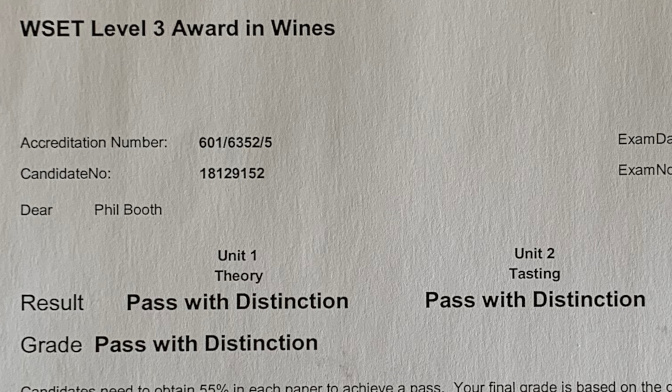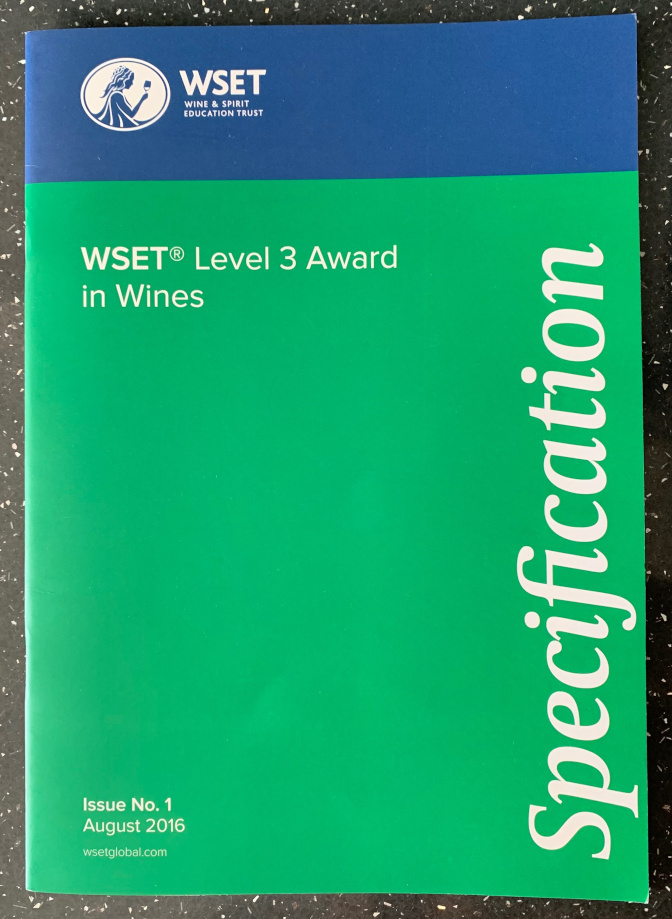Passing the WSET Level 3 Award in Wines
Last week I received the result of my WSET level 3. I got a pass with distinction for both parts of the exam, the tasting and the theory. So, keeping up the tradition I started with level 2, this post summarises my advice for anyone out there thinking about level 3.

Theory papers
As you'd expect, the size of the level 3 subject matter is a significant step up from level 2. There are more grapes and regions to learn about, all in much more detail. There are also significant sections covering the life-cycle of a vine, vine management, and production techniques in the winery. So of course, many more hours of home study are needed at this level.
Fortunately it's possible to pick apart the detail into sections that will only be covered by the multiple-choice paper and others that will be included in the written answer paper too. This is all clarified by the course specification booklet, which is included in the bundle you will receive before starting the course. Especially when you come to revising for the exams, it pays to use the specification to allocate your time between topics appropriately.

The multiple-choice paper is pretty much the same as the one from level 2, just covering a wider set of topics. The written answer paper is a new challenge though, and it's worth spending time practising answering these types of question as much as possible during the course itself and in whatever revision time you have before the exam.
The questions often fall into one of three categories:
-
Describe the style of...
These questions expect you to answer with a structured note, as if you were tasting an example of the wine under exam conditions. You can gauge how much detail is called for by the number of marks next to the question but, bearing in mind you won't lose points for providing too much information, if you answer with a full tasting note, you will always maximise your chance to earn all the marks. So include the appearance, nose, palate, quality and readiness for drinking. Since you'll be well practised at writing these tasting notes by the time you get to the exam, in most cases it shouldn't take you very long to fill out those details.
-
Describe 5 (or 3, or 7, or whatever) factors in the vineyard affecting the style of...
There are two parts to this. Obviously you must name however many factors in the vineyard. Think climate, weather, temperature, aspect, altitude, latitude, grape variety, training, pruning, canopy management, frost, hail, pests, disease, noble rot, harvesting and so on. Sometimes a question will specify human factors and other times it will specify natural factors but regardless, there should be no shortage of things to talk about.
But it's not sufficient simply to name them, you must also discuss how each one affects development of the grapes and, by consequence, the wine itself.
Occasionally you'll get one of these questions where it only says "name the factors...". In that case, you don't have to do the extra discussion and simply naming them is sufficient. So it pays to read the question carefully and make sure you've understood precisely what is being asked.
-
Describe factors in the winery...
Same as before, but now concerning what happens after the grapes have been harvested. Think sorting, destemming, crushing, draining, pressing, maceration (including carbonic and semi-carbonic), fermentation (including whole bunch), punching down, pumping over, rack and return, maturation, oak or inert vessels, autolysis, malolactic fermentation, blending, clarification, stabilisation, bottling and more.
And again, if the question says "describe" or "discuss" it's not enough to just name the factors. You have to talk about how they affect the wine if you want to get all the marks.
There'll be other questions that don't fall into these three types of course, but many of them will (even if sometimes they're worded differently).
Tasting paper
Perhaps the most daunting part of the exam is the tasting paper. Fortunately, there a number of tricks you can use to make it easier.
The first thing to really understand is that the classroom sessions are your opportunity to calibrate your reactions against your instructor's. They will be marking your tasting paper so if you find yourself consistently making the same mistakes, it's important to recognise that early and try different techniques to explicitly correct yourself as the course progresses. For instance, one of the things I struggled with was acidity. I generally found myself over-stating the acidity of wines compared to my instructor, calling things high acidity when she said they were only medium or medium(+). Realising it was a problem, I focused on it a lot in the last few sessions and managed to change my perception by spitting earlier. It turned out that I was giving the wine too much time in the acid-sensitive parts of my mouth, experiencing sensory overload as a result.
Something else I worried about in the classroom sessions was that other students often identified many more aromas and flavours than I was able to. There are tricks you can use to your advantage here too, however. For red wines, you really want to focus on reliably detecting whether a wine is in the "black fruits" or "red fruits" category. For whites, is it herbaceous, citrus, stone fruits or tropical fruits? Some wines cover multiple categories of course, but the point is that once you've identified the broad themes it becomes much easier to focus on individual sub-flavours and ask yourself if you can detect them. And in the absolute worst case, where you're really struggling with a particular wine, there are often flavours that you can gamble on as being common across the board. Bramble is a good one for red wines, as is blossom for whites. And don't forget "simple" is a valid descriptor that will get you a point on wines that really aren't offering very much.
![]()
When thinking about whether a wine exhibits secondary or tertiary flavours, make sure you get at least a couple of examples from each that applies, to make it clear you've identified that aspect. Some flavours exist in multiple categories, so if you only list one example you risk it counting against the wrong category and not picking up all of the available marks.
Also realise that you won't be penalised for putting too many aromas or flavours down within reason, so if you have something in mind but aren't sure about it, don't overthink it and just write it down anyway. The worst thing to do is chase a particular elusive flavour or over-analyse, because it can get you into a state of self-doubt and paralysis. If that happens, it's best to clear your palate with some water, mentally reset yourself and then start afresh.
Have fun
The biggest difference for me at level 3 was how much fun it was compared to level 2.
Level 2 is all about remembering individual facts for the multiple choice paper, which makes it as much a test of memory as it is of true understanding. It's been a while since I sat my level 2, but my abiding impression is of stressing over small details and not really taking in the bigger picture.
At level 3 there's time to really dive into why things are the way they are, which makes it feel like you're starting to truly understand the underlying subject matter. Everything hangs together more coherently and you'll get a lot of ah-ha! moments, where something you learn about a particular region links back to other things you already learned about elsewhere. It's a more satisfying and enjoyable syllabus because of that.
So if you've taken level 2 and are unsure about level 3, I'd recommend it on that basis alone!